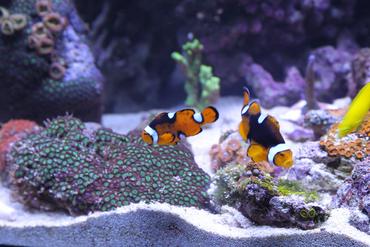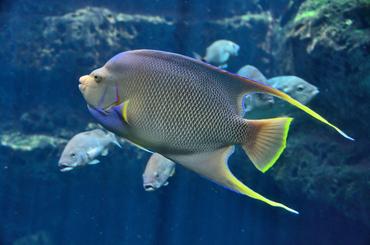HOW TO SOLVE COMMON SALTWATER TANK PROBLEMS

Updated
Cultivating a thriving saltwater tank can be a challenge but it is also incredibly rewarding. Keep reading to learn about common saltwater tank problems and how to fix them.
Any experienced aquarium hobbyist will tell you that there is a lot more involved in keeping a saltwater tank than in keeping a freshwater tank – it is just the truth. But just because maintaining a thriving saltwater tank is a little more challenging doesn’t mean that it isn’t worth it! Saltwater fish are some of the most colorful creatures on the planet and there is something rewarding about caring for a tank full of vibrant, thriving fish. As you do so, however, you are going to experience setbacks and problems – here are some tips for dealing with common saltwater tank problems:
1. Temperature Fluctuations – One of the simplest yet most important things you need to do to keep your saltwater tank healthy is to maintain a stable tank temperature. The ideal temperature for your tank may vary slightly depending on the type of fish you keep, but you should aim for something in the range of 72°F to 84°F as your outside temperatures – something between 75°F and 81°F is better. Keeping the temperature in your tank stable can be a challenge if you live in an area where the climate fluctuates. Your best bet is to invest in a solid aquarium heater (or two if you have a large tank) and hook them up to a thermostat so you can set the ideal temperature you want to maintain. It will also help for you to keep your tank away from direct sunlight and protected from drafts.

2. Algae Growth – Algae growth is a problem in all kinds of aquariums, not just freshwater tanks. There are a number of factors which can contribute to excessive algae growth and most of them are fairly easy problems to deal with. Algae is just like any other living thing – it requires certain nutrients in order to thrive and if those nutrients become available in excess, it will speed growth. Performing routine water changes is important for removing accumulated wastes from your tank – wastes that will produce certain nutrients as by-products that can speed algae growth. It will also help for you to have a quality filtration system in place.
In addition to reducing algae growth, you should also learn how to clean existing algae off your tank and tank decorations. Remove tank decorations and spray them with a weak bleach solution then scrub away the algae before rinsing well and returning them to the tank. For algae on the glass walls of your tank, try a magnetic algae scrubber, a scrub brush, or even a razor blade. It may also help for you to add an algae-eating species of fish or invertebrate to your tank. Just remember that there are different types of marine algae – determine which one is a problem in your tank then choose your new algae-eater accordingly.
3. Cloudy/Yellow Water – Whenever the water chemistry in your tank changes, you will probably notice some physical signs such as changes in water quality, color, or clarity. If the water in your saltwater tank becomes cloudy, it is usually a sign that it is time for some deep cleaning. Fine particulate matter like bits of uneaten fish food and fish waste falls under the heading of “detritus” and if it gets out of control it can become concentrated in your tank substrate as well as the water itself. The best way to deal with this problem is to install a canister filter or a hang-on filter that incorporates some method of mechanical filtration to remove solid wastes from the water column. If you already have one of these systems in place, you may want to check it because it is probably overdue for cleaning.

Not only can the water in a saltwater tank become cloudy, but it may also change in color, becoming increasingly more yellow over time. This usually happens fairly slowly but, if left untreated, it can turn into a big problem. The most common culprit for yellowing tank water in a saltwater aquarium is an accumulation of organic compounds, typically resulting from the breakdown of wastes. The best way to prevent this from becoming a problem in the first place is to keep up with routing water changes. If you are already doing water changes and still have this problem, consider increasing the size or frequency of those changes. It may also help for you to use some high-quality activated carbon in your filtration system (if you aren’t already) or add a filter sock for enhanced mechanical filtration.
4. Aquarium Fish Aggression – While there are certainly plenty of saltwater fish species that do well in a community tank setting, there are just as many (or more) that do not. Before you stock your aquarium, you need to do your research to make sure that the fish you are choosing are compatible with each other and with the conditions in your tank. Even if you are careful, however, it is still possible that your fish could have problems with aggression. If you cannot separate the problem fish, there are a few things you can do in your tank to help reduce aggression. For one thing, make sure that your tank is large enough to comfortably house all of your fish. Next, make sure that you provide plenty of hiding place in your tank – this includes natural caves in the rockwork, overturned clay pots, and other places in which a fish could hide. Adding decorations to break up sightlines and to divide the tank into natural territories could also be helpful in reducing fish aggression.

5. Marine Fish Diseases – No matter what kind of aquarium you are cultivating and what type of fish you keep, you will find yourself dealing with fish diseases at some point. The two most common fish diseases affecting marine species are velvet (Amyloodinium ocellatum) and ich (Cryptocaryon irritans). Both of these diseases (and many others) are extremely contagious and can spread quickly if not treated promptly. In many cases, these diseases are fatal for marine species because treatment is tricky because the most effective treatments will interfere with biological filtration as well as live rock, live sand, and other tank inhabitants. Because treating these diseases can be so difficult, you want to be extremely careful with purchasing and adding new tank inhabitants. Quarantine new tank inhabitants for at least two weeks before adding them to your main tank just to be sure that they aren’t carrying some kind of disease. You should also make every effort to keep the water quality in your tank high because these and other marine diseases tend to flourish in tanks with poor water quality. Poor water quality can also weaken the immune systems of your fish, making them more susceptible to disease.
These are just a few of the many problems you may encounter as you set up and maintain your saltwater tank. Dealing with problems is part of the reality of being an aquarium hobbyist and each problem you face gives you the opportunity to learn something new. So, when you are faced with a new problem, don’t give up – buckle down and find the solution!































































































